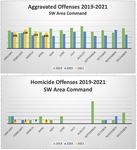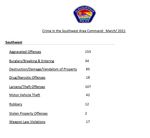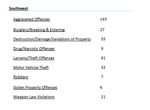SOUTHWEST AREA COMMAND 2021 - Crime Stats
←
→
Page content transcription
If your browser does not render page correctly, please read the page content below
INFORMATION ABOUT
ALBUQUERQUE CRIME STATS
In 2018, the Albuquerque Police Department began reporting crime statistics using the Federal Bureau of
Investigation’s National Incident-Based Reporting System (NIBRS). NIBRS is the most current national
framework for reporting crime and replaces the FBI’s Summary Reporting System (SRS). This change is
important because NIBRS provides more comprehensive and detailed information about crimes against
person, crimes against property and crimes against society occurring in law enforcement jurisdictions
across the country.
The data in this report is based on the official data that APD sends to the FBI. But it is important to note that
the numbers in this report differ slightly from the numbers published in the FBI reports. APD sends NIBRS
data to the FBI on a semiannual basis and this data is based on the reports available at that point in time. The
APD’s crime data system is dynamic and additional information may be added or refined after the data are
sent to the FBI. Although the FBI updates its data bases regularly it does not update published reports.
The data in this report were obtained from APD’s Tiburon RMS computer system on Oct. 16, 2020. Crime
statistics in future reports will differ somewhat from these statistics because this report is also based on a
fixed point in time.CRIME DEFINITIONS
Source: FBI Uniform Crime Reporting Program, National Incident-Based Reporting System
Aggravated Assault: An unlawful attack by one person upon another wherein the offender uses a weapon or displays it in a threatening manner, or the
victim suffers obvious severe or aggravated bodily injury involving apparent broken bones, loss of teeth, possible internal injury, severe laceration, or loss
of consciousness. In the definition above, a weapon is a commonly known weapon (a gun, knife, club, etc.) or any other item becoming one, although not
usually thought of as a weapon, when used in a manner which could cause the types of severe bodily injury described.
Murder and Nonnegligent Manslaughter: The willful (nonnegligent) killing of one human being by another. As a general rule, agencies should classify in
this category any death due to injuries received in a fight, argument, quarrel, assault, or commission of a crime. Although LEAs may charge offenders with
lesser offenses, e.g., Negligent Manslaughter, agencies should report the offense as Murder and Nonnegligent Manslaughter if the killing was willful or
intentional.
Burglary/Breaking & Entering: The unlawful entry into a building or other structure with the intent to commit a felony or a theft. LEAs should classify
offenses locally known as Burglary (any degree), unlawful entry with intent to commit a larceny or felony, breaking and entering with intent to commit a
larceny, housebreaking, and safecracking as burglary. However, because Larceny/Theft is an element of Burglary, agencies should not report the Larceny
as a separate offense if it is associated with the unlawful entry of a structure. The element of trespass is essential to the offense of Burglary/ Breaking and
Entering.
Larceny/Theft Offenses: The unlawful taking, carrying, leading, or riding away of property from the possession or constructive possession of another
person.CRIME DEFINITIONS
Source: FBI Uniform Crime Reporting Program, National Incident-Based Reporting System
Motor Vehicle Theft: The theft of a motor vehicle.
The national UCR Program defines motor vehicle as a motor vehicle is a self-propelled vehicle that runs on the surface of land and not on rails and that fits
one of the following descriptions:
• Automobiles—sedans, coupes, station wagons, convertibles, taxicabs, or other similar motor vehicles serving the primary purpose of transporting people
Robbery: The taking or attempting to take anything of value under confrontational circumstances from the control, custody, or care of another person by
force or threat of force or violence and/or by putting the victim in fear of immediate harm
Robbery involves the offender taking or attempting to take something of value from a victim, usually the property owner or custodian, by the use of force
or threat of force. (The victim must be present.) If there is no direct confrontation and the victim is not in fear of immediate harm, LE should report
Extortion. Though direct confrontation occurs in Pocket-pickings or Purse-snatchings, force or threat of force is absent. However, if during a Purse-
snatching or other such crime, the offender uses force or threat of force to overcome the active resistance of the victim, LE should classify the offense as
Robbery.You can also read

























































